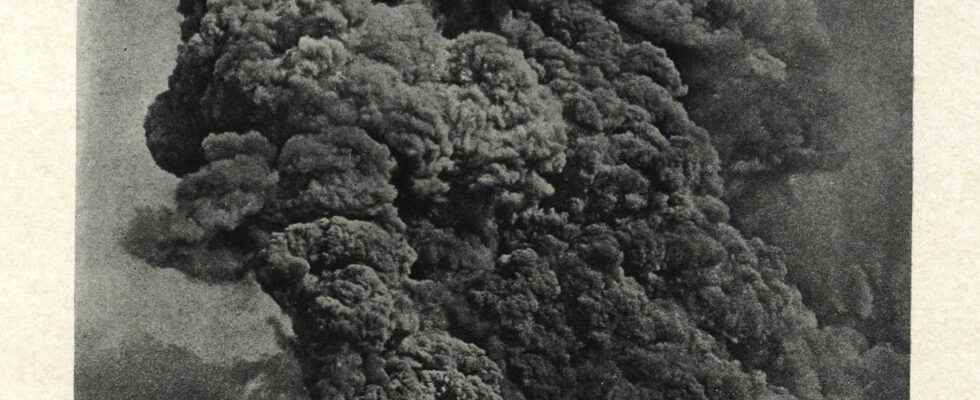You will also be interested
[EN VIDÉO] Are we threatened by supervolcanoes? Volcanoes capable of exceptionally massive and devastating eruption are called supervolcanoes. Their intensity varies but is sufficient to create continental-scale damage. Futura-Sciences met Jacques-Marie Bardintzeff, doctor in volcanology, to learn more about these dangerous volcanoes.
At the start of 1902, Mount Pelée was calm, with only a few fumaroles that had appeared in the summit crater of the volcano during the last two years. At the foot of the volcano, to the south, the town of Saint-Pierre stretches along the shore for several kilometers in length and has a total of around 26,000 inhabitants. True economic and cultural capital of Martinique, nicknamed the “Little Paris of the West Indies”, Saint-Pierre was then nothing like the village of today.
At the beginning, a phreatic activity…
From the beginning of March, smells of sulfur are frequently felt in coastal villages and on April 25, explosions cause some ash fallout in some towns. However, carelessness reigns, no doubt because the activity for the moment resembles that of the last eruption in 1851. It is an activity groundwaterlinked to the heat of one magma in depth which destabilizes the groundwater of the volcano. Moreover, an excursion on April 27 to the summit crater of the volcano, which is then called the caldera of the Dry Pond, allows to notice a lake which partially empties into the White River, a ravine on the south-west flank of the volcano.
On the night of May 2 to 3, a thick column of ashes covered withlightning formed, causing ash fallout over a large part of Martinique. Saint-Pierre wakes up in a fog ashes and some inhabitants of the sector begin to flee… The following days, the emissions of ashes continue, as well as the floods in the White River. Then, on May 5 in the middle of the day, the rupture of the wall of the dry pond caldera generates three impressive mudslides one after the other in this river and in two or three minutes, they arrive at the level of the factory. Gérin, a sugar estate not far from its mouth. The waves of mud are more than 10 meters high at this place and about fifty victims!
The greatest disaster of the XXand century !
The magma comes to the surface the next day, evidenced by denser ash plumes and a incandescent at the base of these. From this date, a lava dome probably forms in the crater, a crater now open in the direction of Saint-Pierre following the events of the previous day. The activity is continuous, spectacular and noisy, but a commission bringing together scientists on May 7 estimates that “the relative position of the craters and the valleys opening towards the sea allows us to affirm that the security of Saint-Pierre remains complete”. 400 people still leave Saint-Pierre that day by steamer to Fort-de-France. That same day, the eruption of Soufrière de Saint-Vincent, a volcano a hundred kilometers away, killed more than 1,500 people and was heard in Saint-Pierre. Bad omen.
On the night of May 7 to 8, very strong thunderstorms accompanied the eruption and caused flooding in various rivers. They devastated several villages, including that of Le Prêcheur, where about 400 victims were recorded.
In the morning, 34 passengers board for Fort-de-France, when many curious people disembark at Saint-Pierre. It’s Ascension Day and many are in church… violent explosion occurs at the base of the lava dome, directed laterally to the southwest, where the crater is open. It forms a powerful Pyroclastic flowa cloud of gas and burning ash, which descended the southwestern flank of the volcano at more than 400 km / h and arrived in Saint-Pierre at 8:02 a.m. The city was almost completely blown away: only a few walls in the southern part are still standing. Of the estimated 28,000 people in the city, there are only two survivors: a shoemaker named Léon Compère and Louis-Auguste Cyparis, a prisoner who was protected by the thick walls of his dungeon! Suddenly submerged sailors and those of a ship that manages to leave also survive. But 28,000 victims in a few seconds… It is the greatest volcanic catastrophe of the XXand century !
After this paroxysm, the eruption continued intensely. Other powerful explosions still took place and the lava dome formed in the crater also generated a number of fiery clouds ofavalanchefollowing thecollapse of certain parts of this dome. In mid-August, the refugees were allowed to return to their town, but on the 30th of the same month, a fiery cloud reached Morne Rouge, a village southeast of the volcano, and claimed 1,000 additional victims…
The eruption continued until june 1905, but the population did not return to Saint-Pierre until many years later. Today it is a modest village, where stigmata of the catastrophe are remarkable in certain places…
This article is largely based on the excellent work of Solange Contour and Simone Chrétien, published in the associative journal WASH n°96 dating from May 2002. For those who wish to know more, I strongly recommend reading ” Mount Pelée wakes up »a book by Simone Chrétien and Robert Brousse published by Boubée.
Interested in what you just read?
